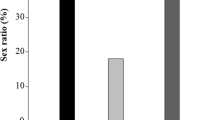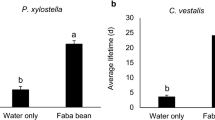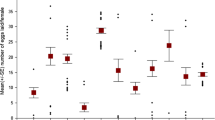Abstract
The choice of insect females as to where to lay their eggs strongly affects progeny survival and, thus, fitness. We conducted choice experiments with female Mexican bean beetles, which were offered lima bean plants differing in their cyanogenic capacity (HCNc), i.e., in the intensity of hydrogen cyanide release per time unit from damaged plant tissue. Females preferred to lay their eggs on plants with low HCNc. In contrast, the mere concentration of cyanide-containing precursors (the cyanogenic potential, HCNp) did not affect oviposition choices. Plant cyanogenesis occurs after tissue damage, which brings specific β-glucosidases in contact with their substrates, cyanogenic glycosides, from which they are separated by compartmentation in the intact plant tissue. Plants commonly store toxic compounds in an inactive form. Our results demonstrate that for cyanogenesis, which is widespread in plants, it is the toxic product itself rather than the precursor that affects oviposition choices of a specialized herbivore.
Similar content being viewed by others
Avoid common mistakes on your manuscript.
Introduction
The fate of the phytophagous offspring of insects is correlated strongly with oviposition on a suitable host plant because larvae usually are limited in mobility (Rausher, 1979). Choice behavior of female insects can be affected by numerous parameters. Factors determining oviposition choice include quantity and/or quality of resources (Myers, 1985), plant morphology, natural enemies, inter- or intraspecific competition, and allelochemicals (Thompson and Pellmyr, 1991). Plant compounds often serve as cues for phytophagous herbivores to identify suitable hosts for feeding and oviposition.
Many plant defenses are based on active compounds that are enzymatically released from glycosylated precursors accumulated in vacuoles. The general question arises whether the deterrent function is exclusively provided by the aglycones or whether the precursors also have a protective effect in themselves, as has been reported for bitter-tasting cyanogenic glycosides (Nahrstedt, 1985).
Cyanogenesis is a two-step mechanism in which cyanide-containing precursors are cleaved by specific β-glucosidases. The resulting α-hydroxynitriles are unstable and decompose spontaneously, or enzymatically, in the presence of α-hydroxynitrile lyase to yield hydrogen cyanide (HCN) and an aldehyde or a ketone. It is, thus, necessary to consider the effect on oviposition choices of both the release of hydrogen cyanide and the content of cyanogenic precursors to understand the role of host plant cyanogenic features in this ecologically important interaction. In lima bean, both factors underlie high quantitative variability (Baudoin et al., 1991; Ballhorn et al., 2005).
We used Mexican bean beetle, which represents an herbivore specialized on members of the Fabaceae. However, the insects show strong preference for cyanogenic lima bean [Phaseolus lunatus (Dover et al., 1988)], and cyanogenic glycosides act as a feeding stimulant for the beetles (Lapidus et al., 1963) indicating some specialization to this host plant. In choice experiments with intact lima bean plants characterized by cyanogenic properties, we addressed effects of cyanide release and cyanogenic precursor concentration on oviposition preference of female beetles.
Methods and Materials
Plants
Lima beans and snap beans were cultivated under greenhouse conditions adjusted to 25:20°C in a 16-hr light/8-hr dark period and a relative humidity of 60–70%. Lima beans were grown from seeds obtained from one mother plant.
Cyanogenic Features of Plants
Cyanogenic capacity (HCNc) was measured in an airflow apparatus according to Ballhorn et al. (2005) using chloroform as an inductive agent for release of gaseous hydrogen cyanide from leaves. By this treatment, the plant's general capacity for cyanogenesis can be quantified. Cyanogenic potential (HCNp) was measured by complete enzymatic degradation of cyanogenic precursors and quantitative measurement of released HCN (Ballhorn et al., 2005).
Beetles
Beetles were reared on noncyanogenic snap bean (Phaseolus vulgaris var. Saxa) under the same ambient conditions as plants. Snap bean represents another important host plant species of the beetle (Dover et al., 1988). Any possible adaptations to particular lima bean accessions were excluded by rearing beetles on snap beans. Beetles that emerged within 3 d were separated from the maintenance culture. Four days after they had started mating, females were removed. In parallel experimental settings, eight female beetles were placed in cages (fabric tubes, 70 cm diam) containing four 30-d-old HC, LC(+), or LC plants of different accessions (replications per combination of plants, N = 4). Order of placement of the four plants in each cage was random to eliminate any possible positional effects for oviposition. Plants were exchanged every 3 d, and the egg clutches on the leaves of the removed plants were counted. Oviposition of beetles was observed over a total period of 30 d.
Statistics
Effects of cyanogenic capacity on beetle oviposition choice and assignment of lima beans to homogeneous groups based on different cyanogenic capacity were carried out by application of a post hoc test [Tukey's honestly significant difference (HSD) test] after one-way analysis of variance (ANOVA) to the data set (Statistica 7.0).
Results
We found significant differences in HCNc and HCNp among the plants. Based on the differences in HCNc, plants were assigned to a high HCN-releasing group (HC) with also high HCNp and to a low HCN-releasing group (LC) with low HCNp. Accessions 2116 showed low HCNc under high HCNp (LC(+)). P. vulgaris cv. Saxa showed no cyanogenic precursors, and thus no ability to release gaseous HCN (Table 1). Screening of P. lunatus leaf material for nutritive factors, such as protein content and total phenolics, revealed, in contrast to cyanogenic variability, no significant differences among the accessions (unpublished data).
Each female beetle usually produced three egg clutches. Clutches were positioned on the undersurface of leaves in intervals of 8–9 d. The oviposition behavior of beetles was affected by the cyanogenic capacity of the lima beans. Beetles showed significant preference for LC plants compared to HC plants (Fig. 1a). In addition, LC(+) plants were preferred for oviposition over HC plants (Fig. 1c), but they were not significantly refused compared to the LC plants (Fig. 1d). Female beetles that were kept exclusively on HC or LC plants showed no preference for single accessions (Fig. 1b, e). Choice experiments including noncyanogenic P. vulgaris plants revealed similar preference of beetles for LC plants compared to P. vulgaris (Fig. 1f).
Oviposition choice of beetles. Shown is the number of egg clutches (mean ± SD, N = 4 per choice experiment) deposited by eight females on leaves of lima beans from accessions with different cyanogenic features (HC  : high HCN-releasing plants; LC
: high HCN-releasing plants; LC  : low HCN-releasing plants; LC(+)
: low HCN-releasing plants; LC(+)
 : low HCN-releasing plants caused by low activity of endogenous β-glucosidase under high concentration of cyanogenic precursors). Plants were assigned to groups based on significant differences in cyanogenic capacity (HCNc; see Table 1). Oviposition preference of beetles was analyzed in parallel experimental settings comprising different combinations of plants (A–F). Saxa* represents noncyanogenic Phaseolus vulgaris cv. Saxa. Different small-typed letters on top of the figure represent significant differences at P < 0.001 (post hoc test after one-way ANOVA; Tukey's HSD).
: low HCN-releasing plants caused by low activity of endogenous β-glucosidase under high concentration of cyanogenic precursors). Plants were assigned to groups based on significant differences in cyanogenic capacity (HCNc; see Table 1). Oviposition preference of beetles was analyzed in parallel experimental settings comprising different combinations of plants (A–F). Saxa* represents noncyanogenic Phaseolus vulgaris cv. Saxa. Different small-typed letters on top of the figure represent significant differences at P < 0.001 (post hoc test after one-way ANOVA; Tukey's HSD).
Discussion
The results show that the Mexican bean beetle, although preferring to feed on lima bean (Dover et al., 1988), avoids high HCN-releasing varieties of its host plant. It was the cyanogenic capacity that affected female oviposition choice. Beetles were repelled by high cyanogenic capacity, whereas high concentrations of cyanogenic precursors did not result in reduced oviposition.
Release of HCN is the result of cell damage. Thus, insect feeding on leaves is required as a precondition for repellent activity. In contrast to other defenses, which can be triggered by oviposition (Hilker et al., 2002), deposition of eggs on plant surfaces per se has no ability to initiate cyanogenesis.
Considering quantitative aspects, beetles did not differentiate between lima beans showing low capacity for release of HCN and snap beans, which did not contain any cyanogenic precursors at all. This finding indicates that cyanogenic capacity at lower concentrations provides no repellent activity against oviposition by female beetles. Both a role of cyanogenic capacity in female choice behavior as well as a homogeneous food quality of lima bean are supported by the finding that female beetles that were kept exclusively on HC or LC plants showed no oviposition preference for single accessions.
In general, nutritive traits have a strong impact on host plant quality and affect female oviposition preference (Raubenheimer and Simpson, 1994). However, substantial differences in host plant quality can be excluded here because we found contents of protein and total phenolics in leaves among the accessions to be homogenous (data not shown).
Taken together, the results demonstrate that oviposition choice of Mexican bean beetles depends on the cyanogenic capacity of host plants at high thresholds.
References
Ballhorn, D. J., Lieberei, R., and Ganzhorn, J. U. 2005. Plant cyanogenesis of Phaseolus lunatus and its relevance for herbivore–plant interaction: The importance of quantitative data. J. Chem. Ecol. 31:1445–1473.
Baudoin, J. P., Barthelemy, Y. J., and Ndungo, V. 1991. Variability of cyanide contents in the primary and secondary genepools of the lima bean, Phaseolus lunatus L. FAO/IBPGR. Plant Genet. Resour. Newsl. 85:5–9.
Dover, B. A., Noblet, R., Moore, F., and Culbertson, D. 1988. An improved artificial diet for Mexican bean beetles based on host preference. J. Agric. Entomol. 5:79–86.
Hilker, H., Rohfritsch, O., and Meiners, T. 2002. The plant's response towards insect egg deposition, pp. 205–233, in M. Hilker and T. Meiners (eds.). Chemoecology of Insect Eggs and Egg Deposition, Blackwell Publishing, Berlin.
Lapidus, J. B., Cleary, R. W., Davidson, R. H., Fisk, F. W., and Augustine, M. G. 1963. Chemical factors influencing host selection by the Mexican bean beetle, Epilachna varivestis Muls. J. Agric. Food Chem. 11:462–463.
Myers, J. H. 1985. Effect of physiological condition of the host plant on the ovipositional choice of the cabbage white butterfly, Pieris rapae. J. Anim. Ecol. 54:193–204.
Nahrstedt, A. 1985. Cyanogenic compounds as protecting agents for organisms, pp. 131–150, in D. Harnett and S. Evered (eds.). Cyanide Compounds in Biology. Wiley, Chichester, UK.
Raubenheimer, D. and Simpson, S. J. 1994. The analysis of nutrient budgets. Funct. Ecol. 8:783–791.
Rausher, M. D. 1979. Larval habitat suitability and oviposition preference in three related butterflies. Ecology 60:503–511.
Thompson, J. N. and Pellmyr, O. 1991. Evolution of oviposition behaviour and host preference in Lepidoptera. Annu. Rev. Entomol. 36:65–89.
Acknowledgments
Seeds and beetles were kindly provided by the “Institute of Plant Genetics and Crop Plant Research (IPK)” in Gatersleben and C. P. W. Zebitz (Hohenheim). We thank Andrea Pietrowski (Bayreuth) and Martin Heil (Essen) for many valuable discussions.
Author information
Authors and Affiliations
Corresponding author
Rights and permissions
About this article
Cite this article
Ballhorn, D.J., Lieberei, R. Oviposition Choice of Mexican Bean Beetle (Epilachna varivestis) Depends on Host Plants Cyanogenic Capacity. J Chem Ecol 32, 1861–1865 (2006). https://doi.org/10.1007/s10886-006-9114-z
Received:
Revised:
Accepted:
Published:
Issue Date:
DOI: https://doi.org/10.1007/s10886-006-9114-z





